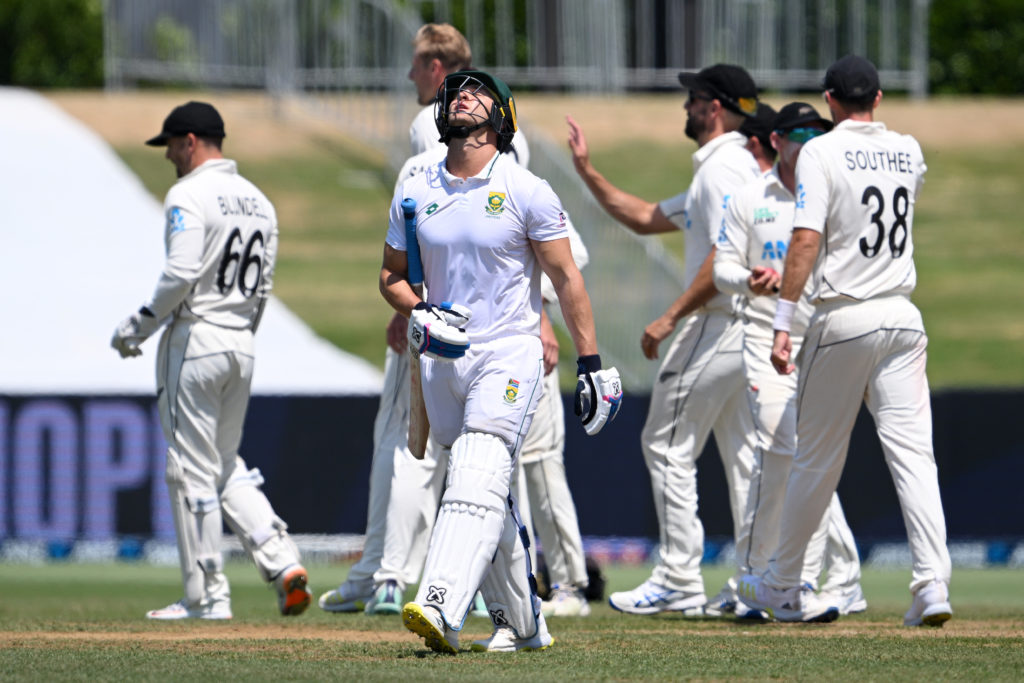The quality of the Proteas’ showing against New Zealand has exposed the quality of our domestic cricket, writes RYAN VREDE.
The Test in Mount Maunganui may have ended late on the fourth day, but it was over as a contest after two and a half days.
South Africa posted 162 in response to New Zealand’s 511. The Black Caps then added 179 runs in 43 overs, to set the tourists 529 to win. They stumbled to 264 on a wicket that offered no significant threat to batters.
This also may have been the most toothless seam attack in the history of South African Test cricket. The primary seamers – Dane Paterson, Tshepo Moreki, and Duanne Olivier – took just three of the 14 New Zealand wickets to fall. Their gentle medium pacers posed little threat and accounted for 400 of the 690 runs (nearly 60%) conceded across the two innings.
By contrast, New Zealand’s seamers took 11 of the 20 South African wickets to fall. They exhibited tactical discipline the Proteas trio could never manage with sustained consistency, seldom bowling loose deliveries and executing tailored plans expertly.
They were undoubtedly aided by batting that deepened concerns about the quality of depth in South African domestic cricket. Eddie Moore chipped the ball ever so softly to cover to start a rot which also featured Zubayr Hamza looping a pull to mid-on, Raynard van Tonder chasing a wide delivery, David Bedingham succumbing in the process of trying to pull boundaries to a stacked leg-side field, and Keegan Petersen hooking a 125kph bouncer straight to fine leg.
Bedingham highlighted the defining difference between the batting sides, saying: “A lot of learnings can be taken from how they batted. They absorbed a lot of pressure in the first two sessions [of day one] and then gave it back to us when our bowlers were a bit tired. For us to get 170 [162] in the first innings was a massive downer. Hopefully, we can take a lot of learnings from this Test.”
Absorbing pressure and then exerting it is a fundamental part of cricket at any serious level. It is not unique to Test cricket. It should be concerning that a side stacked with experienced first-class batters would fail so desperately in this area of the game. Similarly, this level of discipline with the ball should be a standard feature of a first-class bowling unit.
It raises serious questions about the standard of South African domestic cricket, particularly as it relates to it being a training ground for Test cricket.
I’d suggest that winning the series was never on the table, certainly not when you’re contesting it with a clutch of Test debutants and rookies. The more telling metric was always going to be establishing how big the gap is between the standard of Test and domestic cricket. It appears to be a gulf.
This was somewhat evident before the New Zealand tour, expressing itself in a lack of foot movement in Test rookies like Kyle Verreynne, Tristan Stubbs and Tony de Zorzi. Before that, opener Sarel Erwee was exposed technically across his 10 Tests, while Wiaan Mulder has failed to replicate his strong domestic showings, despite being given numerous opportunities.
There are exceptions like Marco Jansen, Gerald Coetzee, Nandre Burger, Petersen and Hamza, who have shown glimpses of being competent Test cricketers. However, for the most part, it appears that graduates to Test cricket from the domestic game have lacked the requisite foundation for success.
It would be remiss not to note that the aforementioned players got their opportunity in relatively experienced teams, while those contesting the New Zealand series don’t have that comfort. They may yet embarrass my view in the second Test.
I hope they do because it will ease fears about the weakness of our domestic cricket. At present, and on the evidence of a dire performance against an average Black Caps side, those fears loom large.







